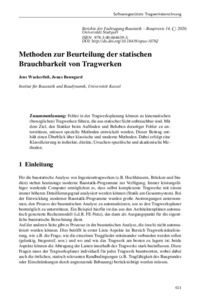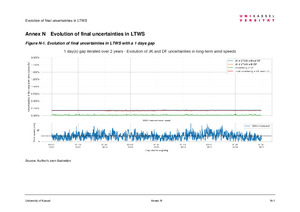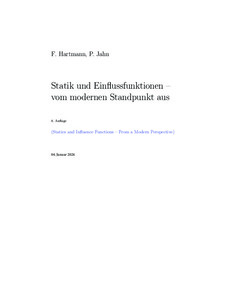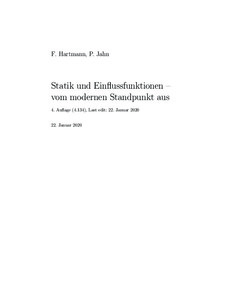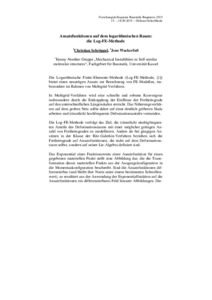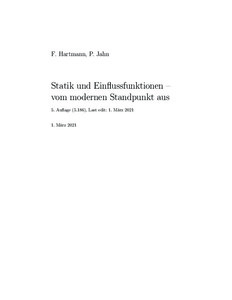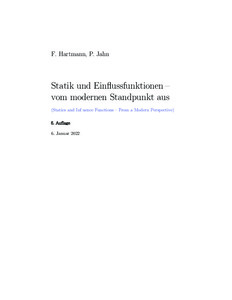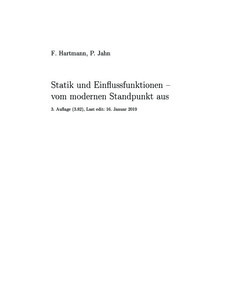Suche
Anzeige der Dokumente 1-10 von 26
Konferenzveröffentlichung
 Methoden zur Beurteilung der statischen Brauchbarkeit von Tragwerken
Methoden zur Beurteilung der statischen Brauchbarkeit von Tragwerken
(Institut für Baustatik und Baudynamik, Universität Stuttgart, 2020)
Fehler in der Tragwerksplanung können zu kinematischen (beweglichen) Tragwerken führen, die aus statischer Sicht unbrauchbar sind. Mit dem Ziel, den Statiker beim Auffinden und Beheben derartiger Fehler zu unterstützen, müssen spezielle Methoden entwickelt werden. Dieser Beitrag enthält einen Überblick über klassische und moderne Methoden. Dabei erfolgt eine Klassifizierung in indirekte, direkte, Ursachen-spezifische und akademische Methoden.
Masterarbeit

 Analysis and Method Selection of a Measure-Correlate-Predict Methodology for a Digital Wind Buoy
Analysis and Method Selection of a Measure-Correlate-Predict Methodology for a Digital Wind Buoy
(2022)
The determination of the site-specific wind conditions has a significant influence on the development and use of offshore wind energy. Lower uncertainties of wind potential result in cost-effective project financing. Floating lidar systems (FLS) or wind lidar buoys have become increasingly common in recent years as a measuring technology for the determination of offshore wind resource. However, due to harsh offshore environmental conditions, offshore measurements with FLS are prone to reliability issues which might ...
Buch

 Statik und Einflussfunktionen - vom modernen Standpunkt aus
Statik und Einflussfunktionen - vom modernen Standpunkt aus
(2024-01)
Moderne Darstellung der Statik der Stab- und Flächentragwerke mit besonderer Betonung der Einflussfunktionen und ihrer Bedeutung für das Rechnen mit finiten Elementen und Randelementen. Aus den Greenschen Identitäten werden die Grundlagen der Statik und des numerischen Rechnens in der Statik entwickelt und gezeigt, wie die Einflussfunktionen wesentlich die Genauigkeit von Finite-Elemente-Berechnung bestimmen. Die Kombination von finiten Elementen und Einflussfunktionen gewährt, über die Numerik hinaus, grundlegende ...
Buch

 Statik und Einflussfunktionen - vom modernen Standpunkt aus
Statik und Einflussfunktionen - vom modernen Standpunkt aus
(2023-01)
Einführung in die moderne rechnerbetonte Statik mit Betonung der wichtigen Rolle, die die Einflussfunktionen für die finiten Elemente bilden, mit Programmen zur Berechnung von Scheiben, Platten und ebenen Rahmen nach der Methode der finiten Elemente und Programmen zur Berechnung von Scheiben, Platten und Laplace-Problemen nach der Methode der Randelemente.
Konferenzveröffentlichung

 The logarithmic finite element method
The logarithmic finite element method
(International Center for Numerical Methods in Engineering (CIMNE), 2018)
The Logarithmic finite element (LogFE) method extends the Ritz-Galerkin method to approximations on a non-linear finite-dimensional manifold in the infinitedimensional solution space. Formulating the interpolant on the logarithmic space allows for a novel treatment of the rotational component of the deformation, and induces a strong coupling between rotations and translations. The Logarithmic finite element method provides
a transformation of the initial configuration that is not restricted to an isoparametric formulation.
Buch
 Statik und Einflussfunktionen - vom modernen Standpunkt aus
Statik und Einflussfunktionen - vom modernen Standpunkt aus
(2020-01-22)
Finite Elemente bedeutet, wie wir heute wissen, rechnen mit genäherten Einflussfunktionen. Dies ist in der Praxis kaum bekannt. Wir haben daher das Thema Einflussfunktionen zum Anlass genommen, die moderne Statik aus ihren klassischen Ursprüngen neu zu entwickeln und ihre wesentlichen Züge in zeitgerechter Form darzustellen, wie sie heute beim Rechnen mit dem Computer gebraucht werden. Behandelt werden die Variations- und Energieprinzipe der Statik, die zentrale Rolle der Einflussfunktionen in der modernen Statik, ...
Working paper

 Ansatzfunktionen auf dem logarithmischen Raum: die Log-FE-Methode [Abstract]
Ansatzfunktionen auf dem logarithmischen Raum: die Log-FE-Methode [Abstract]
(2015-09)
Die Logarithmische Finite-Elemente-Methode (Log-FE-Methode) bietet einen neuartigen Ansatz zur Berechnung von FE-Modellen, insbesondere im Rahmen von Multigrid-Verfahren.
In Multigrid-Verfahren wird eine schnelle und robuste Konvergenz insbesondere durch die Entkopplung der Einflüsse der Freiheitsgrade auf den unterschiedlichen Längenskalen erreicht. Das Näherungsverfahren auf dem groben Netz sollte daher auf einer deutlich gröberen Skala arbeiten und (räumlich) hochfrequente Deformationsanteile vermeiden.
Buch
 Statik und Einflussfunktionen - vom modernen Standpunkt aus
Statik und Einflussfunktionen - vom modernen Standpunkt aus
(2021-03-01)
Den Anstoß zu dem Buch gab die Erkenntnis, dass die Methode der finiten Elemente ein Rechnen mit genäherten Einflussfunktionen ist. Ein klassisches Thema der Baustatik ist mit den finiten Elementen wieder auferstanden. Das war zunächst überraschend, aber es war dann Anlass die Grundlagen der Statik aus der Sicht der computational mechanics neu zu überdenken. Mit computational mechanics meinen wir die grundlegenden Strukturen der Gleichungen: Symmetrie, selbst-adjungiert, positiv definit, Lösungsbedingung, virtuelle ...
Buch

 Statik und Einflussfunktionen - vom modernen Standpunkt aus
Statik und Einflussfunktionen - vom modernen Standpunkt aus
(2022-01-06)
Darstellung der rechnerorientierten Statik mit besonderer Betonung der Rolle der Einflussfunktionen für die moderne Statik:
Den Anstoß zu dem Buch gab die Erkenntnis, dass die Methode der finiten Elemente ein Rechnen mit genäherten Einflussfunktionen ist. Ein klassisches Thema der Baustatik ist mit den finiten Elementen wieder auferstanden. Das war zunächst überraschend, aber es war dann Anlass die Grundlagen der Statik aus der Sicht der computational mechanics neu zu überdenken. Mit computational mechanics meinen ...
Buch
 Statik und Einflussfunktionen - vom modernen Standpunkt aus
Statik und Einflussfunktionen - vom modernen Standpunkt aus
(2019-01-15)
In dem Buch werden die Grundlagen der klassischen Statik in einer modernen, zeitgemäßen Form dargestellt. Dabei wird auf Präzision und Prägnanz in der Darstellung Wert gelegt. Spezielles Gewicht wird auf Einflussfunktionen gelegt, da diese die Basis der finiten Elemente bilden. Das Rechnen mit finiten Elementen ist, wie in dem Buch gezeigt wird, ein Rechnen mit genäherten Einflussfunktionen. Der Text geht ausführlich auf die Fragen der Modellierung von Tragwerken mit finiten Elementen und der Genauigkeit der numerischen ...

